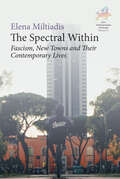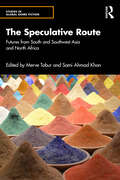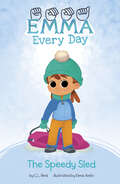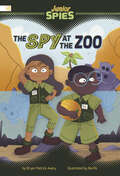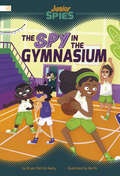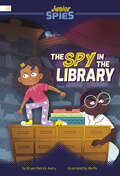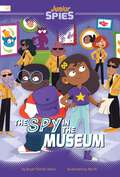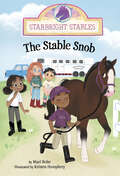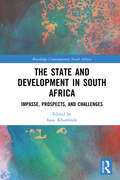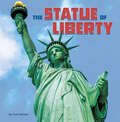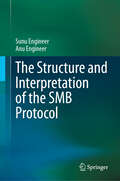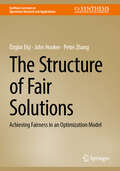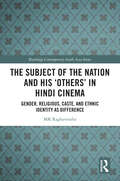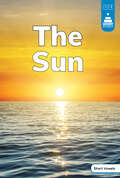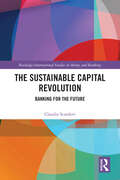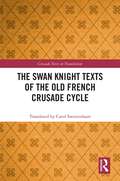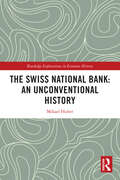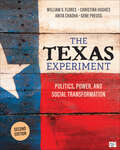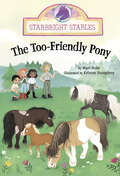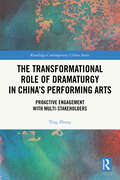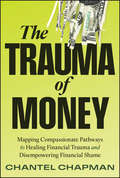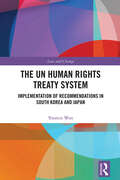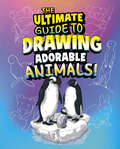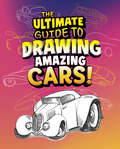- Table View
- List View
The Spectral Within: Fascism, New Towns and their Contemporary Lives (New Anthropologies of Europe: Perspectives and Provocations)
by Elena MiltiadisLatina was founded in 1932 by the Fascist Regime and is often described by its inhabitants through its absences, as a place where there is ‘nothing’. The book examines the role of absence in place-making and delves into the lived experience of Latina. Through the analytical lens of haunting, this work explores its inhabitants’ efforts to see their city as a meaningful social space, as they navigate its multiple histories and the absent presence of the contested past.
The Speculative Route: Futures from South and Southwest Asia and North Africa (Studies in Global Genre Fiction)
by Merve Tabur and Sami Ahmad KhanThe Speculative Route explores speculative traditions and science fictional modes across South and Southwest Asia and North Africa (SSWANA), examining their historical connections, inter- and intra-regional entanglements, overlaps, and differences. Conceptualizing science fiction and fantasy (SFF) as a mode rather than a genre, this volume challenges the putative boundaries between literary and genre fiction through critical studies and essays focusing on SFF from Bangladesh, Egypt, India, Iran, Pakistan, Palestine, Sri Lanka, and Turkey. It demonstrates the ways in which science fictional modes of thinking and imagination function as critical tools for addressing social, cultural, and political issues beyond genre conventions and expectations. Bringing together articles by leading scholars of SFF and think-pieces by acclaimed authors of contemporary SF, this volume focuses on central themes such as the relationship between aesthetics and politics, alterity, world-building, memory, trauma, colonialism and decolonization, ecology, gender, religion, and mythopoetics. It engages with the past, present, and future of speculative traditions in SSWANA, and compares the visions that emerge from these seemingly disparate––but historically connected––entities.Part of the Studies in Global Genre Fiction series, this volume will be of great interest to academics, students, and practitioners in the fields of genre studies (notably, SF, SFF), comparative literature, media and popular culture, area studies, postcolonial studies, and future studies, as well as to readers who are interested in exploring SFF works from the Global South.
The Speedy Sled
by C. L. ReidAfter an epic snowfall, Emma is ready to try sledding. But it's a lot scarier than she thought it would be! Emma wears a cochlear implant because she's Deaf, and she's worried it might fall off. Emma must face her fears to discover new fun in this early chapter book.
The Spy at the Zoo
by Bryan Patrick AveryThe Junior Spies are at it again! This time, Kat and Harry’s mission is to uncover a R.A.V.E.N. plot at the zoo. As they investigate, they discover that the zoo’s real hippos have been swapped with inflatable ones. What is R.A.V.E.N. planning with these fake hippos, and can the Junior Spies foil the evil spy agency’s plot? Young readers will find out in this hi-lo spy adventure that supports phonics skills and fosters reading success.
The Spy in the Gymnasium
by Bryan Patrick AveryThe Junior Spies are at it again! This time, Kat and Harry go undercover on their school’s basketball team. Their mission is to protect the star player, Remy. But when Remy gets kidnapped, the Junior Spies suspect a R.A.V.E.N. agent might be in their midst. Can they find the hoops hero and uncover the evil agent hiding in their school? Young readers will find out in this hi-lo spy adventure that supports phonics skills and fosters reading success.
The Spy in the Library
by Bryan Patrick AveryThe Junior Spies are at it again! This time, their mission is to memorize a name written inside a magic book. But Kat and Harry soon discover the name is encrypted with a cipher. Can they crack the code before a R.A.V.E.N. agent steals the book? Young readers will find out in this hi-lo spy adventure that supports phonics skills and fosters reading success.
The Spy in the Museum
by Bryan Patrick AveryThe Junior Spies are at it again! This time, Kat and Harry must deliver a secret message to a fellow spy at a museum. But at their meeting place, everyone is dressed exactly the same! How will they tell the difference between their contact and the R.A.V.E.N. agents in the room? Young readers will find out in this hi-lo spy adventure that supports phonics skills and fosters reading success.
The Stable Snob
by Mari BolteA new rider is coming to Starbright Stables! Bess, Dot, and Lily are so excited to meet her and her horses! But after Micah arrives, it’s not quite like what the girls expected. Micah’s rude, snobbish attitude soon tests Bess’s patience. But Dot is star struck by Micah’s talent. Will Micah create a wedge between the girls’ friendships? Or will they all find a way to get along?
The State and Development in South Africa: Impasse, Prospects, and Challenges (Routledge Contemporary South Africa)
by Isaac KhambuleThis book interrogates the nexus between the state and development in post-apartheid South Africa. It highlights current problems, and suggests ways of consolidating state capabilities, improving public institutions and enhancing governance and development outcomes.Framed around developmental state theory, the book argues that the role of the state in South Africa will be fundamental for addressing the triple challenges of unemployment, poverty, and inequality. There is a growing concern that South Africa is at a development impasse, with ongoing crises in energy, infrastructure, and unemployment. The chapters investigate the role of the post-apartheid state in pursuing development and navigating a neoliberal globalised society. The book explores state capacity in all spheres of government, the relationship between politics and bureaucracy, and the role of state-owned enterprises in the country’s developmental aspirations. The book concludes by summarising the successes, challenges and lessons that have emerged over the course of the book; and anticipating future directions or possibilities for the state in South Africa’s development impasse.Bringing together leading voices in the field, this book will be an essential read for researchers of African politics, political economy and development. The book is also relevant for policymakers, students and practitioners in social sciences.
The Statue of Liberty
by Cari MeisterThe Statue of Liberty stands in New York Harbor as a symbol of hope and possibility. But where did it come from? And how did it become a promising symbol to American immigrants? Simple, age-appropriate text introduces young readers to this key national symbol and explains its origin and why it is important today.
The Structure and Interpretation of the SMB Protocol
by Sunu Engineer Anu EngineerThis book discusses the current status of the Server Message Block (SMB) protocol and its relevance, use and applications in the data storage world at present. Starting from the origin of the protocol, this book traces the evolution of the protocol through the dark ages, when the protocol was proprietary and its transition into being an open protocol. It also discusses the current applications that use the SMB protocol as well as possible applications in the future. The analysis of the protocol in the book captures the detailed structure as well as the rationale behind the design. It illustrates the relationship between SMB protocol and other protocols in the context of the Microsoft Windows ecosystem as well as the assimilation of SMB into other operating system environments, such as Linux (Unix), Mac OS, Android, iOS etc. The final chapters of this book discuss the questions of performance, scaling and largescale use especially in cloud environments, weaknesses and security issues in the current set of implementations of the protocol. It also examines the question of interoperability of SMB with other popular NAS protocols exposing distributed file system semantics such as NFSv3 and v4. This book is designed for advanced-level students in computer science and engineering as a secondary textbook. Researchers and practitioners working in Data Storage Systems will also find this book useful as a reference, as well as any engineering team that is working on SMB and related protocols.
The Structure of Fair Solutions: Achieving Fairness in an Optimization Model (Synthesis Lectures on Operations Research and Applications)
by John Hooker Özgün Elçi Peter ZhangThis book provides a novel and unifying perspective on the structural properties of fair solutions in optimization formulations. The book also addresses a growing interest in incorporating fairness into the models that lie behind many business and public policy decisions. Since there are several ways to formulate fairness mathematically, the authors characterize optimal solutions that result from different formulations with the aim of informing the choice of an appropriate model for a given application. The focus is on fairness criteria that combine efficiency with fairness since typically both are important in practice. Most of these results are new and do not appear in the current literature. The book is directed towards a wide range of audiences including practitioners, researchers in mathematical optimization, and welfare economists. In addition, this book: Presents practical linear, nonlinear, or mixed integer programming formulations and a wide variety of fairness models Includes detailed proofs that provide insight into the properties of each criterion Provides guidelines for selecting a fairness model and the tendency to incentivize cooperation or competition About the Authors Özgün Elçi, Ph.D., is a Research Scientist on the Modeling and Optimization team at Amazon. John Hooker, Ph.D. is University Professor of Operations Research and T. Jerome Holleran Professor of Business Ethics and Social Responsibility, Emeritus, at Carnegie Mellon University. Peter Zhang, Ph.D, is an Assistant Professor at Carnegie Mellon University’s Heinz College of Information Systems and Public Policy.
The Subject of the Nation and his 'Others' in Hindi Cinema: Gender, Religious, Caste, and Ethnic Identity as Difference (Routledge Contemporary South Asia Series)
by MK RaghavendraThis book analyzes the representations of the subjects of Hindi cinema as a way of gaining insights into the hegemony of the upper-caste Hindu male in narratives of nationhood.Given that Hindi cinema has narrativized the nation after 1947, the book examines how these subjects were chosen and argues that they were upper-caste, Hindu and predominantly male. The author's analysis shows asymmetries in the constitution of the ‘imagined nation’ in the public consciousness. Women, the marginalized categories, and minorities were presented as ‘others’ with separate stories for the issues dealing with them—but distinct from that of the nation. Stories centered on women primarily highlight their position within society. In this context, the book argues that it is the male protagonist whose story mirrors that of the nation as allegory.A novel contribution to the field of Bollywood Studies, this insightful work will be of interest to those studying Hindi cinema and film studies, political science and history, as well as gender studies.
The Sun
by Laura StickneyThe sun plays an important role in daily life. Beginning readers hone their phonics skills while learning facts about that great, big ball of gas in the sky! As readers practice decoding words with short vowel sounds, they gain science knowledge. Every Stairway Decodables nonfiction book combines multiple aspects of the Science of Reading to support small group instruction, independent reading, and reading practice at home.
The Sustainable Capital Revolution: Banking for the Future (Routledge International Studies in Money and Banking)
by Claudio ScardoviModern capitalism has focused on profit maximization at the expense of non-renewable natural resources. This has led to wealth polarization – that is, social unsustainability – and climate change – that is, environmental unsustainability. Value migration has occurred between the ultra-rich and the “remaining 99%” and across generations, with increased longevity and a demographic winter expected to contribute even more. All this has led us on a collision course with several existential threats.This book explains that a quick and decisive sustainability conversion is necessary, requiring significant investment and careful management of trade-offs – such as those between environmental and financial risk. The author argues that a “sustainable capital” approach would account for all scarce resources used in any investment decision and adjust its risk-based pricing. It would redefine the foundations of modern finance and economics, overcoming the limits and negative implications of well-known metrics and supporting the funding required for green conversion and reduced wealth polarization. Ultimately, a “sustainable capital” approach could inform long-term sustainability transformation strategies and be used to develop a first set of pragmatic, market-based initiatives, involving non-bank funding and an operating partner approach, to accelerate a “wealth to wellbeing” and a “brown to green” transformation and the workout of the (otherwise stranded) socially and environmentally non-performing assets – securing the survival and evolution of our eco-system.This book is aimed at those involved in the world of finance, investment management, and banking, with a specific focus on sustainable finance and green transformation. It will also be of relevance to readers interested in economic policies and the broader topic of equality, social sustainability, and wealth creation.
The Swan Knight Texts of the Old French Crusade Cycle (Crusade Texts in Translation)
by Carol SweetenhamThe Swan Knight texts provide an imaginary tale of the ancestry of Godfrey of Bouillon, first ruler of Jerusalem in the kingdom of Outremer. They form the opening section of the Old French Crusade Cycle, leading up to the fictionalised account of the crusade in the Chanson d’Antioche, Chanson des Chétifs and Chanson de Jérusalem. They comprise six stories: two versions of the childhood of Godfrey’s fictional ancestor, the Swan Knight, in the Elioxe and the Béatrix; his battles with the Saxons and marriage to Béatris in the Chevalier au Cygne; his death in the Fin d’Elias; the childhood of Godfrey and introduction of his counterpart Cornumarant in the Enfances Godefroi; and the Retour de Cornumarant, linking the story of the Swan Knight to the central trilogy of the Cycle.This is the first translation of all six texts into English. The introduction covers the sources, manuscripts, context and later developments of the text culminating in Wagner’s Lohengrin. There is a full list of characters and places as well as brief notes on and summaries of the texts.The translations are designed to make the beginning of the Cycle accessible to modern readers with an interest in the history and literature of the crusades and/ or in folklore. They open up a vast medieval panorama populated by fairy brides and evil grandmothers, children turned into swans and back into humans, knights defending maidens and lecherous squires doing the opposite, scheming abbots and Saracen princes, taking place in an imaginary universe stretching from London to Mecca by way of Boulogne and Bouillon.
The Swiss National Bank: An Unconventional History (Routledge Explorations in Economic History)
by Mikael HuberEchoing new trends in central banking history, this book traces the story of the Swiss National Bank from the end of World War II, going beyond monetary policy and inflation to explore the full scope of the bank’s activities.Drawing on extensive archival research, it examines the broader landscape in which the central bank operated, including the role of Swiss banks, government oversight via the Federal Council, the influence of the international monetary system, and the negotiation of central bank independence — particularly the use of non-legal instruments and their limitations within Switzerland’s decentralised political system. Throughout, the Swiss National Bank had to reconcile three sometimes conflicting factors: corporate liberalism, which allowed major economic players a say in policy; the imperative of maintaining the stability of the Swiss franc; and the need to kerb potential threats to monetary stability. In response, the SNB developed a sophisticated arsenal of non-legal and unconventional tools to regulate the financial system on a temporary basis. The history of these exceptional measures sheds light on the unconventional evolution of the Swiss National Bank.This book will appeal to readers of economic history, financial history, central banking, and Swiss history.
The Texas Experiment: Politics, Power, and Social Transformation
by William V. Flores Christina Hughes Anita Chadha Gene PreussThe Texas Experiment: Politics, Power, and Social Transformation provides an all-encompassing view of Texas government. Authors William V. Flores, Christina Hughes, Anita Chadha, and Gene Preuss bring together the historical and the contemporary, the political and the personal, to walk students through the state′s past, present, and future. Through the book′s rich historical narrative that tells the unvarnished story of how Texas came to be, depictions of the processes and structure of Texas government, and finally, insights on shifting demographics, we learn that the soul of Texas is multicultural, diverse, and thriving. The Second Edition has been updated through the state′s 2023 legislative cycle and what it means for those living in Texas.
The Texas Experiment: Politics, Power, and Social Transformation
by Christina Hughes William V. Flores Anita Chadha Gene PreussThe Texas Experiment: Politics, Power, and Social Transformation provides an all-encompassing view of Texas government. Authors William V. Flores, Christina Hughes, Anita Chadha, and Gene Preuss bring together the historical and the contemporary, the political and the personal, to walk students through the state′s past, present, and future. Through the book′s rich historical narrative that tells the unvarnished story of how Texas came to be, depictions of the processes and structure of Texas government, and finally, insights on shifting demographics, we learn that the soul of Texas is multicultural, diverse, and thriving. The Second Edition has been updated through the state′s 2023 legislative cycle and what it means for those living in Texas. This text is offered in Sage Vantage, an intuitive learning platform that integrates quality Sage textbook content with assignable multimedia activities and auto-graded assessments to drive student engagement and ensure accountability. Unparalleled in its ease of use and built for dynamic teaching and learning, Vantage offers customizable LMS integration and best-in-class support. Instructors, see how Vantage works! Take a brief self-guided tour with our interactive demo
The Too-Friendly Pony
by Mari BolteRiders from Starbright Stables Bess, Dot, and Lily are on a camping trip to a state park. The best part? The park has wild ponies! The girls follow the park rules and avoid feeding the ponies. They watch the ponies from a distance. Then they notice one pony is overly friendly. It follows the girls around. And it has green frosting on its nose! Then they find cupcakes left all over the park. Is someone leaving food out for the ponies? The girls know that a pony that becomes too comfortable with people may need to be removed from the park. Can the girls solve this frosting-filled mystery before it’s too late?
The Transformational Role of Dramaturgy in China’s Performing Arts: Proactive Engagement with Multi-Stakeholders (Routledge Contemporary China Series)
by Ting ZhangA pioneering examination of a field in its early stages, Zhang delves into a detailed exploration of the evolving role of dramaturgy in contemporary Chinese theatre, bridging the gap between established Western theories and the unique practices emerging in the Chinese theatre scene, and offering valuable insight into the reshaping of theatre production amidst a rapidly changing cultural landscape.Compared with the development of dramaturgy in Western countries, dramaturgical practice in contemporary Chinese theatre is still in its infancy. This book aims to fill this gap by exploring dramaturgy’s evolution and current role in Chinese theatre. It embarks on a global exploration—in terms of both dramaturgical theories and practices—across Germany, the UK, the US, and the Asia-Pacific region, providing a theoretical framework. It then traces the evolution of Chinese spoken drama (Huaju) from its origins in 1907 to the present. This chronological exploration illuminates Huaju’s development from foreign influences in the early decades to a more recent era of self-exploration. The book features three key case studies: the reception of Henrik Ibsen’s work in China, the 1983 production of Arthur Miller’s Death of a Salesman in Beijing, and the writing and staging of Teahouse. It also explores contemporary dramaturgical practices in China, based on fieldwork and interviews with theatre practitioners in Beijing and Shanghai. Through an examination of the similarities and differences in dramaturgical practices across performing arts in China, the book firmly positions Chinese dramaturgy within the broader currents of global theatre discourse.This book is a unique cross-cultural resource with practical insights and theoretical reflections of great value for academics, scholars, educators, and practitioners in the fields of theatre studies, dramaturgy, cross-cultural performance studies, contemporary Chinese theatre, and the global evolution of dramaturgy.
The Trauma of Money: Mapping Compassionate Pathways to Healing Financial Trauma and Disempowering Financial Shame
by Chantel ChapmanA handbook to disempower the trauma standing between individuals and their financial wellbeing The Trauma of Money: Mapping Compassionate Pathways to Healing Financial Trauma and Disempowering Financial Shame offers a comprehensive exploration of the Trauma of Money Method™, an innovative six-phase approach to decrease shame and increase discernment around money. It spotlights the myriad causes of financial trauma, tracing its roots to their generational, relational, societal, and systemic origins, and guides readers in understanding how trauma directly impacts our financial behaviors. Changing the narratives that come with these traumas is the first step in recognizing that true financial literacy hinges on this foundational healing. This book includes research-based modalities to transform readers' approaches to finances, including somatic trauma healing, narrative therapy, cognitive behavioral therapy, mindfulness, internal family systems, addiction recovery therapies, biomimicry, systems change and financial psychology. It also includes practical tools such as: Reflection questions and prompts to intentionally evolve our relationship with money and scarcity as well as tools for addressing financial shame Methods to identify and shift away from trauma responses like financial fawning, somatic exercises to regulate the nervous system, and ways to reprogram our subconscious Approaches to reclaim and deepen the commitment to our money values and integration activities that can be used with clients The Trauma of Money: Mapping Compassionate Pathways to Healing Financial Trauma and Disempowering Financial Shame is an illuminating, effective resource for financial advisors and planners, mental health professionals, entrepreneurs, or anyone seeking to move out of automatic trauma responses and into their financial power.
The UN Human Rights Treaty System: Implementation of Recommendations in South Korea and Japan (Law and Change)
by Yoomin WonThrough a use of both qualitative and quantitative methodologies, Won provides a nuanced analysis and discussion of the factors and domestic processes influencing the implementation of United Nations Human Rights Committee (UNHRC) recommendations in South Korea and Japan, as well as across the globe.Won’s research entangles the theoretical debate on whether the UN human rights treaty system is effective in prompting the implementation of HRC recommendations. Based on interviews with activists, lawyers, scholars, judges, and other practitioners in South Korea and Japan, her findings reveal contrasting domestic dynamics: South Korea's vibrant institutional landscape enables more active implementation, while Japan's stable but centralized political system leads to more incremental change. In addition, Won creates a novel empirical dataset to assess the key variables associated with improvement in human rights action across 103 countries. The findings suggest that institutional mechanisms enhance implementation in new democracies, while civil society plays a crucial role even in authoritarian regimes. Ultimately, frequent and constructive dialogue between states, treaty bodies, and civil society, supported by institutional protections, is key to turning recommendations into human rights change.A unique empirical analysis of international human rights action as driven by UN recommendations, this book will be of interest to scholars and students of international law, human rights, and international relations, as well as human rights lawyers and the NGO Human Rights Communities.
The Ultimate Guide to Drawing Adorable Animals!
by Kathryn ClayFluffy, feathery, and oh-so-cute! Learn how to draw some of the world’s most adorable animals, from playful puppies and cuddly koalas to hopping kangaroos and waddling penguins. With easy-to-follow steps and beginner-friendly instructions, budding artists will master the art of drawing cute critters in no time. Whether sketching a sleepy sea lion or a tiny tree frog, this book makes learning to draw both simple and fun.
The Ultimate Guide to Drawing Amazing Cars!
by Aaron SautterStart your engines and grab your pencils! It’s time to draw some seriously cool cars! From classic muscle cars to futuristic speedsters, this book is packed with projects to help you bring your dream rides to life. Learn how to sketch sleek designs, add realistic details, and master dynamic perspectives. Whether you love drag racers, hot rods, or race cars, this step-by-step guide will take your drawing skills over the finish line.
